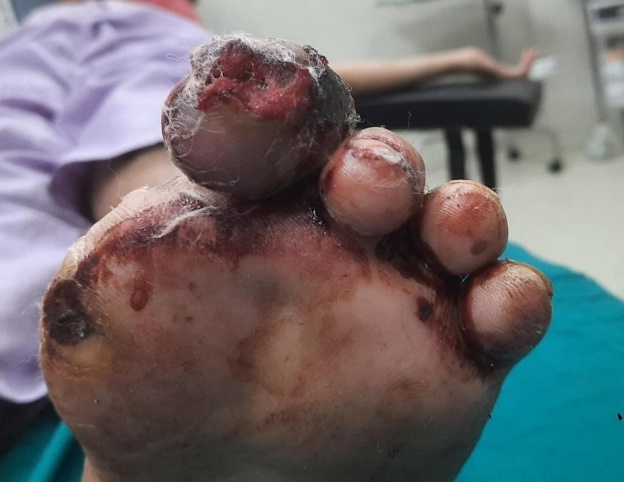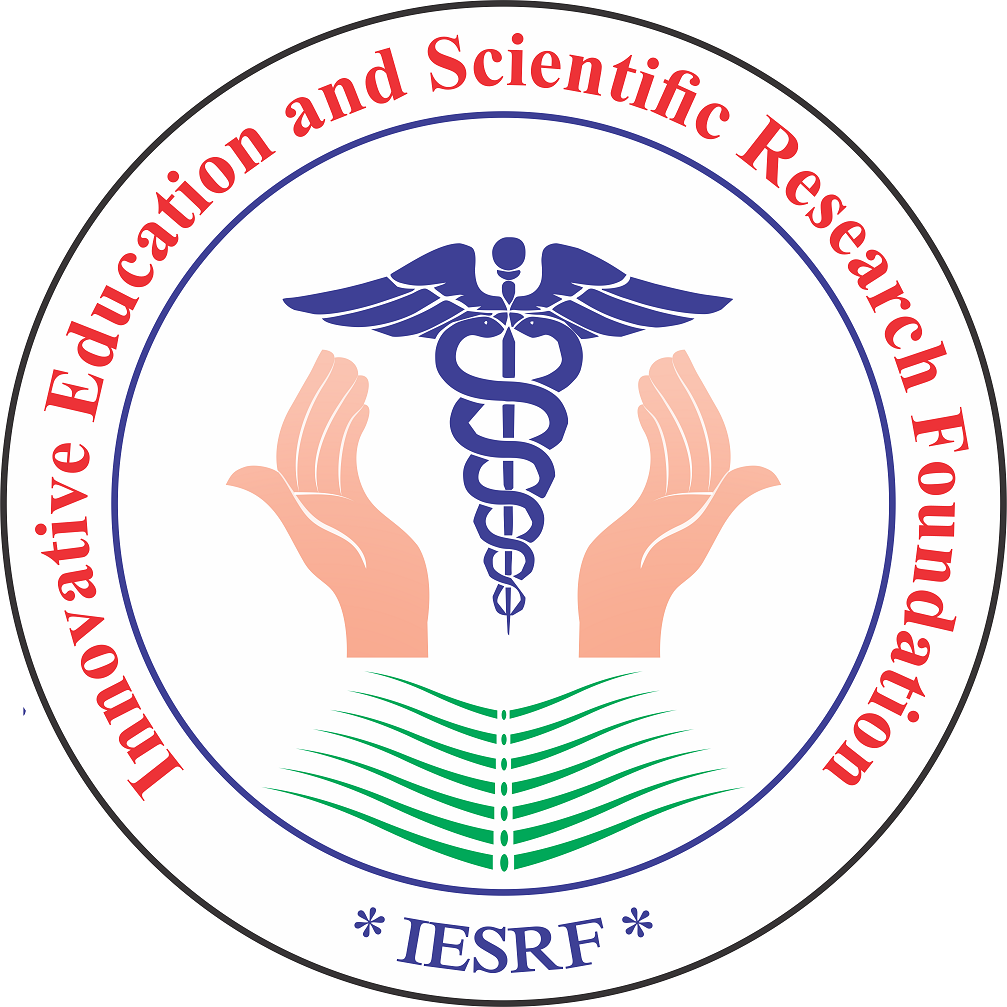- Received August 08, 2024
- Accepted August 22, 2024
- Publication December 09, 2024
- Visibility 2 Views
- Downloads 0 Downloads
- DOI 10.18231/j.ijmr.2024.060
-
CrossMark
- Citation
Salmonella Paratyphi B wound infection in a diabetic foot a rare case presentation
Introduction
Salmonella spp. typically cause enteric fever but can also, though rarely, lead to skin and soft tissue infections and osteomyelitis.[1] The development of these complications depends on factors such as bacterial load, strain virulence, host immunity, effectiveness of treatment, and prior exposure. Risk factors for focal salmonella infections include extremes of age, immunosuppression, underlying malignancy, intravenous drug use, and previous trauma.[2] Wound infections caused by pathogens like Staphylococcus aureus, Pseudomonas aeruginosa, Klebsiella pneumoniae, Enterococcus faecalis, and Acinetobacter baumannii have been extensively documented in diabetic patients.[3] Here, we present a remarkably rare case involving a diabetic foot wound infection affecting the second toe of the left foot, attributable to Salmonella Paratyphi B.
Case Presentation
A 44-year-old male patient presented to the surgical outpatient department of our hospital with complaints of swelling and discoloration on his left foot persisting for the last 3-4 months. He reported a history of trauma to the affected site approximately 10 months ago. Additionally, the patient has been experiencing high-grade intermittent fever for the past 10-15 days. The patient has a significant medical history of type 1 diabetes mellitus, which has been managed with medication for the past 40 years. Previous surgical interventions include cholecystectomy, lobectomy of the left lung, and amputation of the great toe of the left foot.
A diffuse, smooth, ill-defined swelling was noted upon clinical examination, extending from the base of the 2nd metatarsal to the tip of the 2nd toe. The overlying skin exhibited redness, without any signs of discharge, sinus, fistula, or dilated veins. Hematological investigation revealed a normocytic normochromic blood picture with neutrophilic leukocytosis. Additionally, liver function tests indicated a slightly elevated direct bilirubin, with all other parameters falling within normal limits. A bilateral lower limb ultrasound venous Doppler showed no evidence of deep venous thrombosis.

A swab from the infected site of the left second toe was sent to the microbiology laboratory for culture and sensitivity testing.([Figure 1]) Following standard laboratory procedures, the specimen was immediately inoculated onto blood agar, MacConkey agar, and nutrient agar. All plates were then incubated at 37°C for 18-24 hours. Direct Gram staining of the specimen revealed the presence of polymorphonuclear leukocytes (>25 cells/low power field) along with Gram-negative bacilli.
Following the incubation period, grey/white, non-hemolytic colonies were observed on blood agar, while non-lactose fermenting colonies were observed on MacConkey agar. These colonies were identified as Salmonella Paratyphi B using both conventional biochemical methods and the Vitek 2 compact system (GN ID Card). Confirmation of Salmonella Paratyphi B was also achieved through agglutination with specific Antisera Salmonella O Poly A, confirming it as Samonella species, with O antigen factor 4 and H antigen phase 1 b (Difco-BD India Pvt Ltd) confirming its species. Antimicrobial susceptibility testing was done by using the Vitek 2 compact system (AST N406) and Kirby-Bauer disk diffusion method, which revealed susceptibility to all tested drugs. Given the uncommon occurrence of the pathogen, a follow-up sample was collected three days after the initial one, confirming the continued presence of the same organism. Due to chronic non-healing nature of the ulcer, ultimately, surgical amputation of the left second toe was performed and the patient was treated with Amoxicillin/clavulanic acid (625 mg, TDS) for 10 days.
|
Antibiotic |
MIC(µg/ml) |
Interpretation |
|
Ampicillin |
25mm (by disk diffusion method) |
S |
|
Trimethoprim/ sulfamethoxazole |
≤20 µg/ml |
S |
|
Ciprofloxacin |
≤0.06 µg/ml |
S |
|
Ceftriaxone |
29mm (by disk diffusion method) |
S |
|
Cefepime |
≤0.12 µg/ml |
S |
|
Meropenem |
≤0.25 µg/ml |
S |
|
Azithromycin |
25mm (by disk diffusion method) |
S |
Discussion
According to a global study on the Bacteriological Profile of Diabetic Foot Infections, Gram-negative organisms were found to be more prevalent than Gram-positive organisms. Pseudomonas aeruginosa was the most frequently isolated, followed by Klebsiella pneumoniae, Escherichia coli, and Acinetobacter baumannii, among others. Among Gram-positive bacteria, Staphylococcus aureus was the most commonly isolated organism.[3]
Salmonella species are typically associated with enteric fever but have also been sporadically reported to be linked with skin, soft tissue infections,[1], [4] and osteomyelitis.[5] There have been reported cases where Salmonella Typhi was found in wound infections.[6], [7] There are even reported cases of hard-to-heal diabetic ulcers due to Salmonella Paratyphi A.[1]
We came across a rare case of diabetic foot wound infection affecting the second toe of a 44-year-old male due to Salmonella Paratyphi B. This occurrence mirrors findings from case studies published by Sergiu-CiprianMatei, where Salmonella Paratyphi B was isolated from infections in venous leg ulcers,[8] and by Pramod S. Manthalkar, who encountered a case of postoperative wound infection in a 21-year-old female, also with Salmonella Paratyphi B.[9] These incidences underscore the emerging recognition of Salmonella Paratyphi B as a potential agent in various types of wound infections, shedding light on its diverse clinical manifestations beyond its classical presentation in gastrointestinal illnesses.
Conclusion
Diabetes increases the risk of Salmonella infections in the skin, soft tissue, and osteomyelitis. Diabetic patients are immune-compromised, making them vulnerable. It's crucial to consider uncommon pathogens like Salmonella Paratyphi B in diabetic wound infections. This case in India is the first reported instance of isolating Salmonella Paratyphi B from a diabetic wound. It expands our understanding of the rare causes of diabetic wound infections and their complications.
Limitation of Study
We requested urine, stool, and blood cultures from the patients, but couldn't obtain them. This limitation in our study made it difficult to determine whether the infection source is endogenous or exogenous.
Consent of Patient
Taken.
Source of Funding
Nil.
Conflict of Interest
Nil.
References
- A Dilhari, S Pathirage, C Gunasekara, N Fernando, D Weerasekara, A Mcbain. Salmonella enterica serovar Paratyphi A isolated from a hard-to-heal diabetic ulcer: a case report. J Wound Care 2020. [Google Scholar]
- NM Zehra, L Satti, F Hanif, S Nadeem. Unilateral breast abscess by an extremely drug-resistant salmonella enterica serovar typhi: First case report from Pakistan. J Clin Diagn Res 2019. [Google Scholar]
- A Atlaw, HB Kebede, AA Abdela, Y Woldeamanuel. Bacterial isolates from diabetic foot ulcers and their antimicrobial resistance profile from selected hospitals in Addis Ababa, Ethiopia. Front Endocrinol (Lausanne) 2022. [Google Scholar]
- Y Minohara, T Kato, M Chiba, K Doi, Y Kurihara, M Kusakado. A rare case of Salmonella soft-tissue abscess. J Infect Chemother 2002. [Google Scholar]
- V Venkataram, B Subramanian, M Muthulingam. A Case Report of Salmonella Typhi Osteomyelitis with Pathological Fracture in an Immunocompetent Adult. Cureus 2020. [Google Scholar]
- S Sengupta, K Jagadishchandra, R Murty, PG Shivananda. An unusual post-operative wound infection with Salmonella typhi: case report. Indian J Med Sci 2000. [Google Scholar]
- M Sfeir, P Youssef, JE Mokhbat. Salmonella typhi sternal wound infection. Am J Infect Control 2013. [Google Scholar]
- SC Matei, CS Dumitru, AM Fakhry, N Ilijevski, S Pešić, J Petrović. Bacterial species involved in venous leg ulcer infections and their sensitivity to antibiotherapy-an alarm signal regarding the seriousness of chronic venous insufficiency C6 stage and its need for prompt treatment. Microorganisms 2024. [Google Scholar]
- PS Manthalkar, S Kulkarni, SL Hiremath, S Dhotre. An unusual post-operatiave wound infection with salmonella paratyphi b: a case report. J Evol Med Dent Sci 2014. [Google Scholar]
